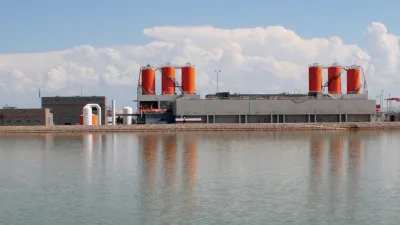Farmers in the Monterey Bay area of California have been feeding their artichoke plants with recycled urban wastewater. And they've been doing it safely for years.
About 12,000 acres total are irrigated with the recycled wastewater -- though that's just a drop in the bucket in farm-rich California.
"For most people - especially those not living in arid areas of the southwestern United States - the phrase "toilet to tap" elicits unpleasant images. Even in water-strapped California, only about 500,000 acre-feet of recycled water - just 1 percent of the total - are used each year. But population growth and other factors, including climate change, are dictating that California and other dry states become more efficient in their use of water. One water-treatment facility has found a way to really get the most out of its water, perhaps charting the course for other thirsty areas of California.
"Not only were we the first, but we're the largest raw-food crop-water recycling project in the world [that] we know of," says Keith Israel, general manager of the Monterey Regional Water Pollution Control Agency. The agency's regional treatment facility, which blends into the flat agricultural terrain so completely that you might not know it existed unless you were told, intercepts 20 million gallons of sewage water from 12 communities dotting the Monterey Bay coastline every day, treating the wastewater and recycling it to 30 Castroville growers via a system of purple pipes."
FULL STORY: From Sewage to Artichokes

Planetizen Federal Action Tracker
A weekly monitor of how Trump’s orders and actions are impacting planners and planning in America.

Congressman Proposes Bill to Rename DC Metro “Trump Train”
The Make Autorail Great Again Act would withhold federal funding to the system until the Washington Metropolitan Area Transit Authority (WMATA), rebrands as the Washington Metropolitan Authority for Greater Access (WMAGA).

DARTSpace Platform Streamlines Dallas TOD Application Process
The Dallas transit agency hopes a shorter permitting timeline will boost transit-oriented development around rail stations.

Renters Now Outnumber Homeowners in Over 200 US Suburbs
High housing costs in city centers and the new-found flexibility offered by remote work are pushing more renters to suburban areas.

The Tiny, Adorable $7,000 Car Turning Japan Onto EVs
The single seat Mibot charges from a regular plug in about as much time as an iPad, and is about half the price of an average EV.

Supreme Court Ruling in Pipeline Case Guts Federal Environmental Law
The decision limits the scope of a federal law that mandates extensive environmental impact reviews of energy, infrastructure, and transportation projects.
Urban Design for Planners 1: Software Tools
This six-course series explores essential urban design concepts using open source software and equips planners with the tools they need to participate fully in the urban design process.
Planning for Universal Design
Learn the tools for implementing Universal Design in planning regulations.
Roanoke Valley-Alleghany Regional Commission
City of Mt Shasta
City of Camden Redevelopment Agency
City of Astoria
Transportation Research & Education Center (TREC) at Portland State University
US High Speed Rail Association
City of Camden Redevelopment Agency
Municipality of Princeton (NJ)





























